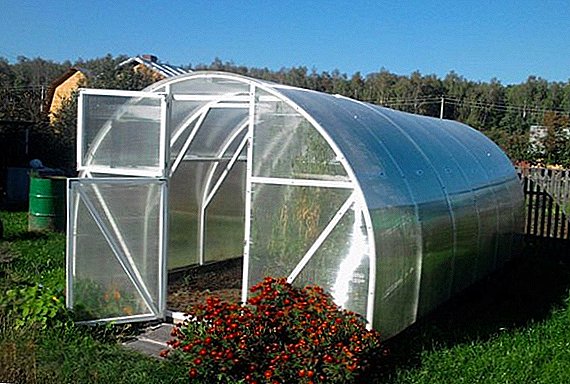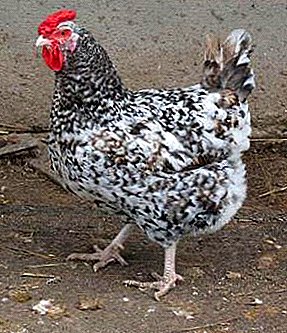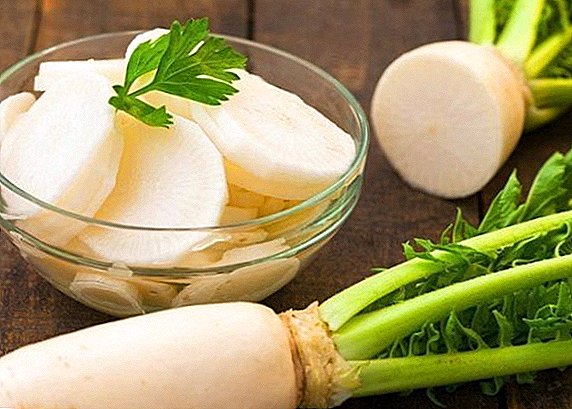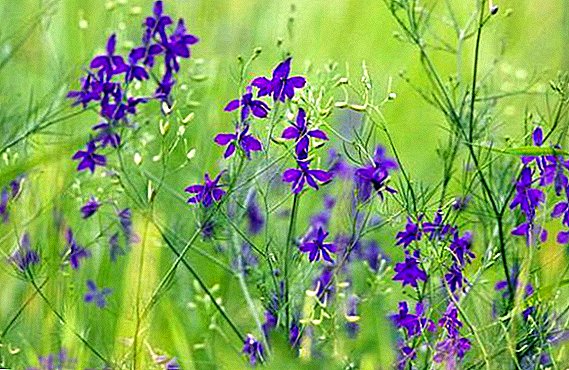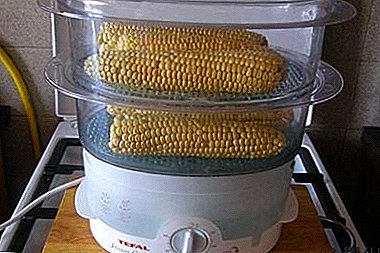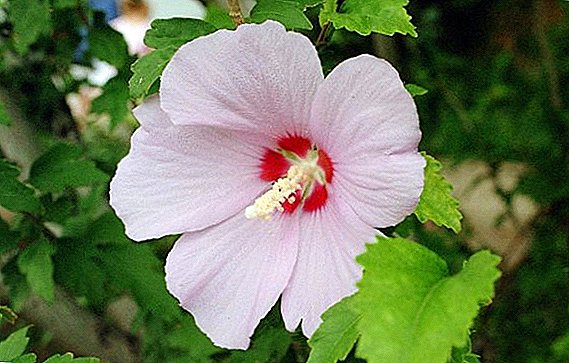 As soon as the cold recedes and the first spring days arrive, garden centers and shops for gardeners begin to offer all sorts of berry crops, varietal roses and other ornamental plants. Sometimes sellers offer nondescript seedlings with an unusual and memorable name "Hibiscus".
As soon as the cold recedes and the first spring days arrive, garden centers and shops for gardeners begin to offer all sorts of berry crops, varietal roses and other ornamental plants. Sometimes sellers offer nondescript seedlings with an unusual and memorable name "Hibiscus".
Buyers are confused and doubt whether to buy such a seedling, because it is known that hibiscus is an indoor plant known to gardeners under the second name "Chinese rose". The proposed plant is indeed a hibiscus, but it is a hibiscus garden, street, and its correct name is Syrian hibiscus. In this article we will try to give the reader the knowledge of how to grow hibiscus garden, how to provide him with the right care and make it possible to reproduce the variety.
Botanical description
Syrian hibiscus (Hibiscus syriacus) is a tropical plant, absolutely not adapted to survive in cold winter conditions. In natural habitat there are more than 200 species of this plant. At home, hibiscus is a shrub perennial, there the plant blooms throughout the warm season.  In our climatic region, hibiscus blooms all summer, flowering begins in July and lasts until the end of September. There are a lot of flower buds on a plant, so the short life of each flower does not detract from the overall decorativeness of the plant. Within two days the flower passes the phase from blooming to gradual wilting and shedding.
In our climatic region, hibiscus blooms all summer, flowering begins in July and lasts until the end of September. There are a lot of flower buds on a plant, so the short life of each flower does not detract from the overall decorativeness of the plant. Within two days the flower passes the phase from blooming to gradual wilting and shedding.
Hibiscus belongs to the Malvaceae family. Lavatera, cotton and abutilon also belong to this genus.
Hibiscus flowers are very large, almost gigantic - the diameter of an unfolded flower reaches 20-25 cm. The color of flower petals is white, pink, dark crimson, scarlet, violet, - their color depends on the type of hibiscus.
The height of the flower bush reaches 1.5-2 meters by autumn.
Did you know? Hibiscus not only surprises and pleases flower growers with a pleasant floral aroma and spectacular, bright flowering - the petals of its flowers are the basis for brewing a very tasty drink, known as tea carcade.
Where to plant a bush
Syrian hibiscus - a garden flower, its place in the garden, rock gardens and flower beds. It is perfectly adjacent to the bushes of roses and thickets of lavender, which surrounds the hibiscus bushes delicate smell. The aroma of lavender will decorate a warm summer evening and will not let a small pest, aphids and other harmful insects, settle on the leaves of hibiscus.  And of course, acquiring such a beautiful plant, it is better not to hide it in a far corner of the garden, because such a spectacular bloom needs admiring spectators. It is best to find a cozy place for hibiscus in the central flowerbed or on the porch of the house, because every morning dozens of fresh huge tropical flowers will bloom on a grass tree.
And of course, acquiring such a beautiful plant, it is better not to hide it in a far corner of the garden, because such a spectacular bloom needs admiring spectators. It is best to find a cozy place for hibiscus in the central flowerbed or on the porch of the house, because every morning dozens of fresh huge tropical flowers will bloom on a grass tree.
Location and lighting
If, while planting in a flower bed of a tropical guest, the florist wishes to provide him with the most comfortable conditions, you need to choose a good sunny place, safely covered from the northern, cold winds and drafts by some kind of structure or fence, that is, to ensure an exotic plant a reliable rear.  If you can offer hibiscus only light partial shade - the newcomer will still delight you with beautiful flowering. Absolute intolerance in a grass tree only to darkened, poor in sunlight places.
If you can offer hibiscus only light partial shade - the newcomer will still delight you with beautiful flowering. Absolute intolerance in a grass tree only to darkened, poor in sunlight places.
Important! When you buy a varietal hibiscus for open ground, make a choice in favor of a plant with terry (multi-layered) flowers. It is varieties with double flowers that are less susceptible to freezing during the cold season.
Growing soil
Like any actively growing plant, a tropical beauty needs fertile soil. The flower loves soils with good aeration and drainage, because when the clay soil stagnates water at the root system, it will cause rot and oppression in the growth of the flower, and possibly its death. If the land in your flower bed is poor, not fertilized for a long time, then before planting hibiscus you need to bring it to the desired state.  If the soil in your flower garden is clayey, this can be corrected by adding half a bucket of crushed peat powder to each square meter of the surface of the flowerbed. Simultaneously with the enrichment of the loose component of the soil, you can add dressing (rotted manure, humus, mineral fertilizers). All that we want to bring to the soil of our flower garden is spread on the ground in an even layer and dug over with a spade with a turn of the bayonet.
If the soil in your flower garden is clayey, this can be corrected by adding half a bucket of crushed peat powder to each square meter of the surface of the flowerbed. Simultaneously with the enrichment of the loose component of the soil, you can add dressing (rotted manure, humus, mineral fertilizers). All that we want to bring to the soil of our flower garden is spread on the ground in an even layer and dug over with a spade with a turn of the bayonet.
The dug up soil is leveled with a rake and watered. The soil is ready for the landing of tropical settlers. This land is great for bookmarking the rose garden.
If you have sandy soil, then instead of peat to it you need to add a half-bucket of ordinary garden soil and dig up a future flower garden. 
Planting rules seedlings
In order for a purchased sapling to succeed, it is necessary to follow some simple rules when it is transplanted into the open ground:
- when you brought home a sapling in a container, it does not need to be watered - before changing the flower, its root ball should remain completely dry;
- Before transferring the plant, it is necessary to prepare (dig up) a planting pit for the flower. If the land in the flowerbed is not pre-fertilized, then the landing pit rumbles 20-25 cm deeper than needed for planting, and a humus spade is put into it or saltpeter is filled up (a matchbox). Fertilizer mixed with soil. Before planting, the depth of the landing pit should be equal to the depth of the container with the seedling;
- the container where the seedling is located, you need to gently tap on the walls with a knife, thereby helping the dry basal coma to separate from the pot. By tilting the container, the gardener will be able to remove the earthen room and carefully put it in the prepared landing pit;
- when the hibiscus is set in a pit for planting, the side spaces of the hollow that remain unfilled are covered with soil;
- remembering that before planting the flower needed to be watered, it was well watered.
Important! Such a careful transplant is called "transshipment" and provides almost one hundred percent survival of plants in a new place (in a large pot or in a new flower bed). This method can be applied to any valuable plants.It must be remembered that planting a Syrian hibiscus requires some space so that the gardener can provide the flower with watering and care in the open field. An adult plant is tall and rather wide — a bush can grow up to 70 cm in diameter — therefore, the landing holes for hibiscus planting should be at least one and a half meters apart.
Care in the open ground for the flower will ease the support to which the grass tree will be tied up as it grows. Untied flowers can be overwhelmed with heavy winds or heavy rain.
How the plant multiplies
Hibiscus can be propagated in two ways:
- sowing seeds;
- green cutting.
Seeds
Hibiscus seeds for seedlings can be sown in a seedling box or garden plenichok. If the sowing will take place in a seedling box in the house, you can sow the seeds in early March, if the florist will sow in a street greenhouse, the sowing dates will move in the second half of May or in the first decade of June.  Hibiscus seeds are laid out in pre-prepared planting furrows (the depth of which does not exceed 1 cm), covered with soil and watered. Before the first shoots, the seedling box is covered with polyethylene, which is removed only with the appearance of the first sprouts. Street greenhouse also kept closed, opening it only for moderate irrigation and ventilation.
Hibiscus seeds are laid out in pre-prepared planting furrows (the depth of which does not exceed 1 cm), covered with soil and watered. Before the first shoots, the seedling box is covered with polyethylene, which is removed only with the appearance of the first sprouts. Street greenhouse also kept closed, opening it only for moderate irrigation and ventilation.
Further care of the seedlings of the southern guest consists in loosening furrows between the rows, in timely watering, insecticide treatment from aphids and thinning seedlings. To determine whether it is time to thin out the seedlings in the nursery, it is possible by the appearance of the first two true leaves of the plants.  When the flowers appear 5-6 true leaves and the height of young plants reaches 15-25 cm - they can dive into a flower bed, in pots or in a more spacious seedling box.
When the flowers appear 5-6 true leaves and the height of young plants reaches 15-25 cm - they can dive into a flower bed, in pots or in a more spacious seedling box.
Cuttings
To propagate the hibiscus growing in the garden, you need to wait until the end of July, when the bush gathers a leaf mass sufficient for grafting. For cutting material cut green cuttings. The length of such a cutting should be at least 12-15 cm in length, it should contain 2-3 internodes. Cuttings soaked for 10-15 minutes in a special solution for root growth.
To do this, you can use the ready store preparation "Kornevin" or soak the planting material in a solution of water and honey (10: 1.5) or a solution of water and aloe juice (10: 1), which are excellent natural growth stimulants.
After processing the cuttings with root-forming preparations, they are planted in small containers and watered. After that, the pot with the planted cuttings is covered with a plastic bag, which prevents the evaporation of moisture from the soil and increases the formation of young roots on the cuttings. It turns out a mini hothouse.  Packages from a storage tank must be removed daily to ventilate and shake off the condensation that forms. After two weeks, the breeding grounds are opened (removed polyethylene). Further care for young hibiscuses is watering and loosening the soil. In the event of an attack on farmed cuttings of harmful insects, they can be treated with any insecticide.
Packages from a storage tank must be removed daily to ventilate and shake off the condensation that forms. After two weeks, the breeding grounds are opened (removed polyethylene). Further care for young hibiscuses is watering and loosening the soil. In the event of an attack on farmed cuttings of harmful insects, they can be treated with any insecticide.
After 40-50 days, cuttings with regrown roots are seated in separate pots with a capacity of at least 3-5 liters. During this period, the plant can be formed by nipping skeletal branches, which will give an impetus to the flower for additional branching. Reproduction of Syriac hibiscus by cuttings is a simple process and accessible even to a novice florist.
Important! Young hibiscus obtained from seeds will bloom only in the third or fourth year after sowing, so the gardener needs to be patient.For planting cuttings use this soil mixture:
- 1 piece of leafy ground;
- 1 part of sod land;
- 1 part of the humus;
- 1 part of coarse river sand;
- a handful of bone meal;
- a handful of ash.
How to care for the view
Garden hibiscus is an unpretentious plant, but after its planting the participation of the grower in the cultivation of the flower tree does not end there. Need regular care and attention.  In order for a grown up guest from the tropics to please a gardener with lush and unusual flowering for 15-16 years, he needs weeding, watering, shaping, feeding the plant and protecting against pests. The flower grower needs to pick off faded and wilted flowers on a bush, this will help the handsome man to extend the flowering period. Southerner must be tied to a rigid support.
In order for a grown up guest from the tropics to please a gardener with lush and unusual flowering for 15-16 years, he needs weeding, watering, shaping, feeding the plant and protecting against pests. The flower grower needs to pick off faded and wilted flowers on a bush, this will help the handsome man to extend the flowering period. Southerner must be tied to a rigid support.
Watering and feeding
During the summer, adult hibiscus bushes need to be fed twice a month. This can be done by scattering ready-made mineral fertilizers near the root layer (above the ground), which will get to the roots of the flower along with moisture during watering. You can fertilize it with liquid fermented feedings on bird droppings or fermented plant residues. This watering is carried out only at the root. Both types of feedings are the most important supplier of nitrogen and other necessary elements in an easily accessible form for plant assimilation.  Fermented concentrated dressing on bird droppings:
Fermented concentrated dressing on bird droppings:
- half a bucket of bird droppings (chicken, pigeon, goose, duck);
- add a bucket of dung to the top with water, close the lid and place in a place accessible to the sun's rays;
- mix the contents of the bucket 1-2 times a week.
Fermented feed based on vegetable raw materials:
- Any large container (bucket, barrel) is taken and filled to half the volume with any plant residues (weeds, nettles, dandelions);
- then the container is filled to the top with water, closed with a lid and left in a sunny place for fermentation;
- twice a week the contents of the tank is mixed.
 Hibiscus is not a big "water-hollow", therefore, if the summer is moderately rainy, you can not water it manually. If there is a prolonged drought at air temperatures above 28 ° C, it is necessary to provide the plants with moisture in the amount of 10 liters per adult shrub weekly.
Hibiscus is not a big "water-hollow", therefore, if the summer is moderately rainy, you can not water it manually. If there is a prolonged drought at air temperatures above 28 ° C, it is necessary to provide the plants with moisture in the amount of 10 liters per adult shrub weekly.Flowering plants are not desirable to be watered over the leaves, since moisture gets on the delicate flower petals, and they lose their decorative effect. The most acceptable option for watering hibiscus - is radical watering.
Rains and frequent irrigation thicken the soil around the plant's stop circle, which makes it difficult for oxygen to reach the roots. Weeds sprout regularly and willingly grow on well-fertilized soil next to flowers. To prevent the weeds from taking away the nutrients from the flowers, we need to regularly weed (once every 10 days) the flowerbed on which the hibiscus grows.
Did you know? The scarlet flower hibiscus garland serves as a sacrificial offering from believers in Hindu temples dedicated to the goddess Kali.
Pruning
In order for the plant to enjoy a lush flowering - it must be properly formed. If the gardener does not interfere with the formation of a flower, then it will bloom less, ugly pulling up. Some craftsmen using a garden pruner not only increase the number of flowers on a plant, but also form the bushes themselves in the form of geometric shapes. Flower buds in hibiscus are laid on young twigs. To stimulate the growth of such branches with flower buds on them, the flower should be cut several times over the summer. The twigs, on which flowers have already blossomed and withered, are shortened by half, in 2-3 weeks new flower buds will appear on them. The plant is not oppressed by pruning, after pinching adult twigs, the bush becomes more magnificent. And most importantly - its bloom will be several times more beautiful and more abundant.
After the street hibiscus has finished the summer growing season, its stem will begin to shrink - this means that the plant needs full pruning (on the ground). This is winter pruning, after which the entire near-root layer of earth near the hibiscus with the onset of the first frost is covered with mulch (peat-crumb, sawdust, shavings, straw). In the spring the mulch (warming) layer is removed from the flower bed.
Did you know? The women of the Hawaiian Islands decorate themselves on holidays with hibiscus flowers in a tree, wreaths are made from them, they are pinned to their hair. This dazzlingly bright flower in Hawaii is called the flower of love.
Diseases and pests
Hibiscus garden (street) may be subjected to the invasion of pests. Like rose bushes, hibiscus loves aphids very much.
Planted alongside repellent plants (lavender, marigolds) or the treatment of flowers with insecticidal preparations will help to combat this scourge.  If the plant does not have enough nitrogen or iron, its leaves may lighten and even brighter, clearly visible veins will appear on them. This trouble is called chlorosis, which means that the plant signals the flower grower that it needs additional feeding.
If the plant does not have enough nitrogen or iron, its leaves may lighten and even brighter, clearly visible veins will appear on them. This trouble is called chlorosis, which means that the plant signals the flower grower that it needs additional feeding.
If the flower drops the leaves, then the reason may be that the root decays. This can happen with frequent, excessively abundant watering, which the plant does not like at all, or pests could start in the roots of a flower (larvae of the May beetle, wireworm).
Spots appeared on the leaf plates of the southerner: this may be caused by spores of the fungus or diseases of a bacterial nature. Such leaves are cut off and burned. The diseased flower is sprayed with fungicides.
In the southern regions, hibiscus is used as a live flower hedge, for these purposes the plant can be directionally formed using pruning.  The result is a blooming scarlet and pink flowers fence. Once planted in the garden a beautiful perennial plant with bright tropical flowers, giants, florist will be able to admire extraordinary, enchanting flowering for many long years. It is enough to show a little patience, love, care - and all this magnificence will bloom for you annually.
The result is a blooming scarlet and pink flowers fence. Once planted in the garden a beautiful perennial plant with bright tropical flowers, giants, florist will be able to admire extraordinary, enchanting flowering for many long years. It is enough to show a little patience, love, care - and all this magnificence will bloom for you annually.


